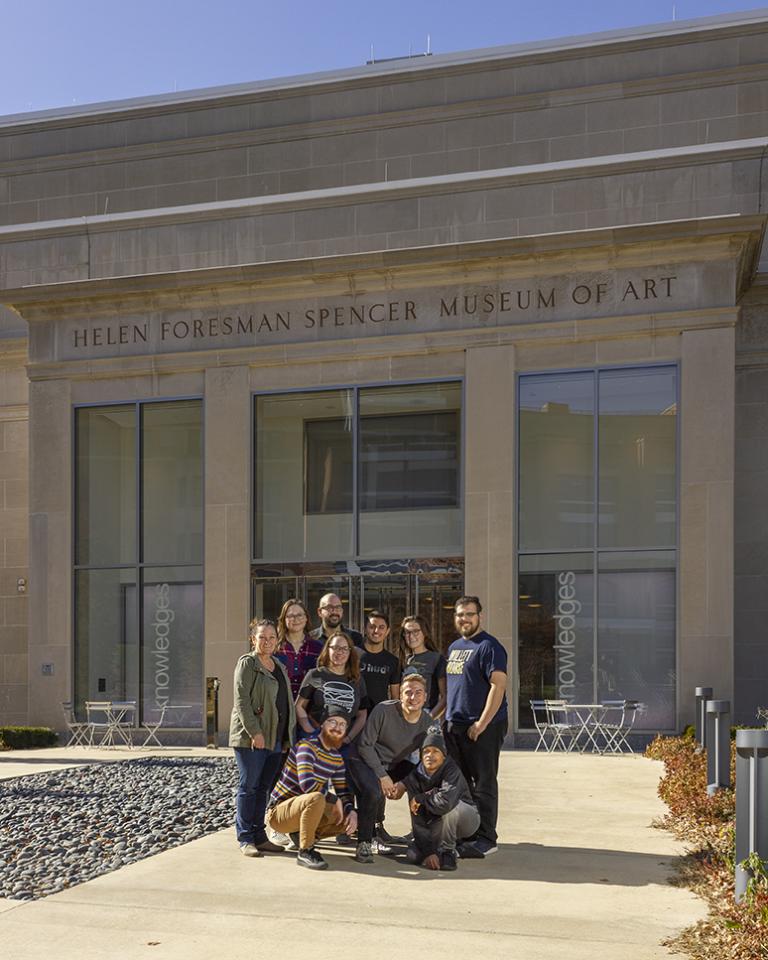Students, faculty attend a2ru national conference
calendar icon25 Nov 2019

Lincoln, Neb.--Associate Dean Christopher Marks, Assistant Professor of Graphic Design Colleen Syron, Assistant Professor of Art Walker Pickering and eight students from the School of Art, Art History & Design attended the a2ru national conference Nov. 7-9 at the University of Kansas in Lawrence, Kansas.
The Alliance for the Arts in Research Universities (a2ru) advances the full range of arts-integrative research, curricula, programs, and creative practice to acknowledge, articulate, and expand the vital role of higher education in our global society. The University of Nebraska–Lincoln is a member.
“Thanks to the generous support of Dean O’Connor, I have been attending the a2ru National Conference for a few years,” Syron said. “As a faculty member interested in elevating arts research on campus, my involvement with a2ru has been invaluable. This year, I was able to encourage Walker Pickering, another faculty member in the School of Art, Art History and Design but outside of my discipline, to join us.”
Syron mentors the student-run organization AIGA student design group on campus. They spent months crafting and writing grants to attend this conference.
“Of the 10 AIGA Student Design Group’s board of directors, eight were funded,” Syron said.
The eight participating students were Andrew Burke-O’Kane, a senior graphic design major; Dan Hinz, a senior graphic design major; Grace de Laittre, a junior graphic design major; Jose Arellano, a senior graphic design major; Marvontay Donovan, a senior graphic design major; Shea Thompson, a junior graphic design major; Josie Briley, a senior graphic design major; and Tyler Loebig, a senior graphic design major.
Donovan enjoyed seeing the work of Fatimah Tuggar at the Spencer Museum of Art.
“First off, Fatimah's work had a warm spot in my heart,” he said. “As an existing minority student where about 80 percent of the student population is white, I felt like she took her resources and used them as an agent for change and voice of persuasion and activism. Her work really brought me to reflect on how I can implement some of the strategies she used and put them in my comic for my senior thesis exhibition.”
Donovan said attending this conference helped open his eyes to some ideas.
“First, you can use design more than to appeal to a brief on a letter page document,” he said. “I learned you can use it as a protest against or for rights that you believe in, in an unconventional way. For example, in Fatimah's work, she uses a hologram and desktops to deliver her message. Second, I learned that the world is shifting more and more towards a media market that focuses on power and not equality. And that we as designers need to use our voices and expertise if we want to see change happen in the near future.”
Burke-O’Kane said what stood out for him at the conference was the diversity of both the presenters and attendees.
“They ranged from an artist that was collecting samples of Queer art from South Korea, to Conservationists that shared compelling stories about the ash tree's that are being decimated by the emerald borers, and how that influenced their art, and even a presentation about drug and PTSD rehabilitation through the use of art. It gave me so many different perspectives in one place that it was kinda insane,” he said.
Arellano said it was important for students to attend the conference.
“This event was important for me to attend because I knew that this was a great opportunity for myself to be a part of and listen to discussions amongst graduates and university faculty about art/design education and research,” he said. “As an undergraduate student, it was a privilege to hear what these individuals had to say. This experience has opened my eyes to new possibilities in my career. The conference really highlighted the design and research process, which is something I believe will benefit me in the long run.”
Syron said the students benefitted from attending the conference.
“The students were delighted at the amazing work and level of interdisciplinary collaboration,” she said. “We learned about projects as diverse as using art instruction in cognitive-behavioral treatment in PTSD veterans suffering from drug addiction to designing outside in the Rocky Mountain National Park to how multidisciplinary artist, Fatimah Tuggar uses technology as both a medium and subject in her work to serve as metaphors for power dynamics.”